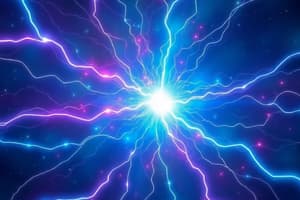Podcast
Questions and Answers
Which scientist named the charges on objects as positive and negative?
Which scientist named the charges on objects as positive and negative?
- Benjamin Franklin (correct)
- Thomas Edison
- Isaac Newton
- Albert Einstein
What object is conventionally referred to as having a positive charge?
What object is conventionally referred to as having a positive charge?
- Glass rod (correct)
- Aluminum foil
- Copper wire
- Plastic rod
Why do the charges acquired by objects neutralize each other's effects when brought in contact?
Why do the charges acquired by objects neutralize each other's effects when brought in contact?
- To increase their charge
- To reduce their stability
- To attract other charged objects
- To nullify each other's effect (correct)
Which apparatus is commonly used to detect charge on a body?
Which apparatus is commonly used to detect charge on a body?
How do the gold leaves in a gold-leaf electroscope behave when a charged object touches the metal knob?
How do the gold leaves in a gold-leaf electroscope behave when a charged object touches the metal knob?
What is the term used to describe a body with no electric charge?
What is the term used to describe a body with no electric charge?
What is the value of ε0 in SI units?
What is the value of ε0 in SI units?
Which vector denotes the position leading from charge q1 to q2?
Which vector denotes the position leading from charge q1 to q2?
If charges q1 and q2 are of the same sign, what does F21 denote?
If charges q1 and q2 are of the same sign, what does F21 denote?
In Coulomb's law, what does F21 represent?
In Coulomb's law, what does F21 represent?
If charges q1 and q2 are of opposite signs, what does F21 denote?
If charges q1 and q2 are of opposite signs, what does F21 denote?
How is the direction of a vector specified?
How is the direction of a vector specified?
What is the acceleration that an electron undergoes under the action of Coulomb force?
What is the acceleration that an electron undergoes under the action of Coulomb force?
What is the acceleration of the proton under the action of Coulomb force?
What is the acceleration of the proton under the action of Coulomb force?
What is the magnitude of force between the charged metallic spheres A and B in the given scenario?
What is the magnitude of force between the charged metallic spheres A and B in the given scenario?
What is the expected repulsion of sphere A on the basis of Coulomb's law after touching sphere C?
What is the expected repulsion of sphere A on the basis of Coulomb's law after touching sphere C?
What is the distance between spheres A and B after B is brought closer to A to a distance of 5.0 cm from the initial distance of 10 cm?
What is the distance between spheres A and B after B is brought closer to A to a distance of 5.0 cm from the initial distance of 10 cm?
What effect does touching uncharged sphere D have on sphere B before it is brought closer to A?
What effect does touching uncharged sphere D have on sphere B before it is brought closer to A?
What is the direction of the electric field when using the formula for dipole field at a point on the normal to the axis of the dipole?
What is the direction of the electric field when using the formula for dipole field at a point on the normal to the axis of the dipole?
What is the result when a permanent dipole is placed in a uniform external field?
What is the result when a permanent dipole is placed in a uniform external field?
What is true about the torque on a dipole in a uniform electric field?
What is true about the torque on a dipole in a uniform electric field?
In what direction is the torque on a dipole in a uniform electric field?
In what direction is the torque on a dipole in a uniform electric field?
What is the relation between p, E, and q in determining the magnitude of torque on a dipole?
What is the relation between p, E, and q in determining the magnitude of torque on a dipole?
How does p x E relate to determining the direction of torque on a dipole in a uniform electric field?
How does p x E relate to determining the direction of torque on a dipole in a uniform electric field?
What type of device did Coulomb use to measure the force between two charged metallic spheres?
What type of device did Coulomb use to measure the force between two charged metallic spheres?
How did Coulomb approximate the charged spheres when the separation between them was much larger than their radii?
How did Coulomb approximate the charged spheres when the separation between them was much larger than their radii?
What assumption was implicit in Coulomb's experiments with charges?
What assumption was implicit in Coulomb's experiments with charges?
What charge did Coulomb assume on a metallic sphere to begin with?
What charge did Coulomb assume on a metallic sphere to begin with?
In Coulomb's experiments, how did he determine the charge on each metallic sphere after putting them in contact with each other?
In Coulomb's experiments, how did he determine the charge on each metallic sphere after putting them in contact with each other?
Why did Coulomb vary the distance between charged spheres in his experiments?
Why did Coulomb vary the distance between charged spheres in his experiments?
Flashcards are hidden until you start studying




